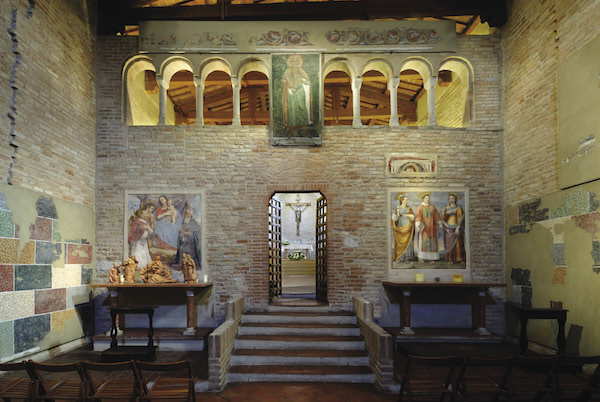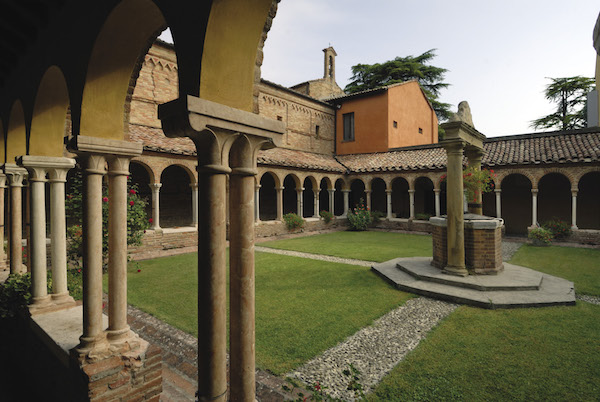Notes in the cloister, notes on the water: music as an intangible but tenacious thread connects and binds two places and two realities so different from each other, but both are the expressions of the spirit, the history, and the soul of Bologna.
Up the hills, at 228 metres above sea level, in a place called Monte Giardino—inhabited since the roman era—is an abbey-church of the 12th century, a testimony to pure Romanesque art. The monastery (or cenobio) of San Vittore, always isolated partly because of unfavourable road conditions, a treasure trove of silent sanctity, had more or less its current appearance when, on March 5, 1178, it was consecrated by Bishop Giovanni IV.
It was Giosuè Carducci, in his capacity as secretary of the Deputazione di Storia Patria, who protected the sacred cenobio from abandonment and neglect throughout history (shutting down of the abbey in 1798 by the emperor; confiscation and devastation in 1866 by military engineering). Returned to the Archbishop’s Curia in 1892, it reopened for worship. The cenobio was expertly restored. Today it joins the essential Romanesque church on two levels, with the frescoes of the 200 and the magnificent 15th-century choir stalls, the delicate elegant cloister of the 15th century, with the 1560 well above the cistern.
It is here that in the summer popular musical events take place, ranging from classical to folk, jazz and pop. If you want to savour the atmosphere and the environment when the water was for Bologna the cornerstone of its economy, the precious “driving force” of its productive activities; if you want to immerse yourself right in the true spirit of Bologna, listening to songs in the regional dialect from popular choirs, the virtuosity of the liscio, then you need to go down in Bassa, on the banks of the Canale Navile crossing the Ponte della Bionda of the 17th-century architecture that then allowed the passage of horses along the towpaths hauling the barges from Bassa and sometimes even from the sea and which now forms the access to the Arena from the Navile. Even here time and neglect have had an impact on the centuries-old architecture. Then, in 2004, a group of “friends of the bridge” formed with passion and ideas a cultural association. The Fondazione del Monte di Bologna e Ravenna provided the funds for the restoration.

Philologically reconstructed parts of the bridge, rebuilt pavement with river stones, cleaned and arranged the green area and the banks of the canal, the Arena of the Navile was born, an area full of cultural-popular, musical-dialectal and also environmental charm. Here the countryside is still the countryside: large trees, a large manicured lawn as a parterre, a large tent as a resting spot with scents of crescentine and friggione, an essential stage for shows (music, recitals, dancing) that the association offers every evening during the summer months.
At the Ponte della Bionda, it is possible to breathe the essence of a culture rooted in this land and its people, a culture of continuity prevailing near the perennial current of Navile, which accompanied so many of Bologna’s stories.
.jpeg)





.png)